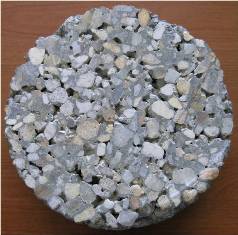We have much more to do and your continued support is needed now more than ever.
Permeable Concrete Reduces Emissions
By Maryruth Belsey Priebe

Traditional concrete made with Portland cement, used for constructing buildings and paving streets, gets its poor carbon reputation primarily from the energy required to manufacture it. The process of calcination requires a great deal of energy to heat calcium carbonate to 2,400°F to form lime, and adds an extra carbon load when lime and silica-containing materials are combined, resulting in the release of carbon dioxide. Transporting heavy ingredients such as sand adds an additional climate impact. Together, these factors play a major role in cement production’s 2.4 percent share of the global industrial- and energy-related carbon dioxide emissions pie.
But manufacturing and transporting concrete aren’t the only energy drains related to traditional concrete. Researchers are currently looking into two end-use climate impacts of concrete: stormwater runoff and increases in the urban heat island effect. Sustainable concrete designs offer solutions to these problems as well as to the issue of energy-intensity inherent in traditional concrete.
First, pervious concrete and permeable pavements help to save energy by mitigating stormwater runoff. Both designs consist of numerous voids (pervious concrete is composed of approximately 20 to 25 percent air space), resulting in a honeycomb-like structure. This permeable nature allows stormwater to drain down through several inches of material where it slowly infiltrates into the soil and eventually replenishes the water table. The water can also be drained into storage tanks where it is held until used on a property for irrigation and other non-potable purposes. An added benefit: the water is naturally filtered as it percolates through the system, removing many environmental pollutants and contaminants, including metals.
By contrast, where traditional concrete pavement is used, institutions invest in facilities to manage stormwater runoff such as catch basins, culverts, detention ponds, storm drains and the like, and energy is then used to convey the water and reintroduce into the environment. An NRDC Technical Report (A Clear Blue Future) notes that the state of California uses 19 percent of its electricity and 33 percent of non-power-plant natural gas for conveying and treating water. Some of this expense could be avoided with pervious surfaces, which are able to virtually eliminate stormwater runoff when properly designed.
“Typical native soils in the US absorb water during rainfall at the rate of 3 inches per hour,” says Dan Huffman, better known as “Mr. Pervious” of the National Ready Mixed Concrete Association. “With pervious concrete, we are very often able to manage stormwater at a rate of 200 inches of rain per hour. So as fast as rain can fall, it hits the surface, goes right through, and is gone.”

Further, pervious pavements and interlocking concrete pavements, can be combined with ground source heat pumps to serve as thermal reservoirs for storage of heat or cold. As David Smith, technical director at the Interlocking Concrete Pavement Institute (an organization that represents the interlocking concrete pavement industry) puts it, “This technology has high potential in many parts of this country. This type of integral technology is what sustainable design and energy conservation are about.”
The second climate benefit of permeable pavements is the savings in cooling costs for buildings near paved parking lots. Dr. Liv Haselbach, associate professor at Washington State University, Pullman, recently presented brand new research at the Countermeasures to Urban Heat Islands Conference that suggests pervious concrete could indirectly help to reduce urban air conditioning requirements by preventing heat transfer. “Go to the beach in the summer and you’ll find the dark asphalt to be very hot on bare feet,” Haselbach illustrates. “If you walk instead on lighter-colored pavement, the heat isn’t as intense, so color matters. But if you walk on dark green grass, it’s not hot either. That’s because soils have voids and holes and can allow some evaporation from water in deeper layers, cooling the surface.”
Working on this premise, the research team (from Iowa State, led by John Kevern) embedded thermocouples into progressively deeper layers underneath traditional concrete and pervious concrete (with an aggregate sub-base of 18 inches). Tracking temperature changes by the hour, they discovered that pervious concrete pulled in slightly less heat than traditional concrete. Despite the fact that pervious concrete is often darker in color compared to traditional concrete, the void structure of pervious concrete acts as insulation and prevents the pavement from storing heat that would otherwise raise evening temperatures and result in a greater use of air conditioning in nearby buildings.
Pervious concrete (recognized as a US EPA Recommended Best Management Practice) and interlocking pavement designs are both commercially available and have been shown to work well in any climate-from Florida to Alaska. Generally speaking, these surfaces last longer (40+ years) than both concrete and asphalt (where resurfacing is required every 15 to 20 years), even in areas where the freeze-thaw cycles are extreme with some 150 year old installations still holding up well.
And it’s not just for low-use areas, either; pervious surfaces have been tested extensively in high-traffic locales as well. UNC-CH has installed permeable pavement at eight locations comprising more than 15 acres of their campus, including four large park-and-ride lots where commuters catch buses. Another site uses permeable interlocking concrete blocks. “Permeable pavement is part of our larger water resources strategy, which also includes using less-energy intensive harvested rainwater and reclaimed water,” comments Sally Hoyt, stormwater systems engineer.
Yet despite its versatility and durability, pervious surfaces have yet to make a significant showing in institutional building plans. “That’s just the way that the construction industry is-we don’t adapt to change very well and there’s lots of interest in protecting the status quo,” says Huffman. “Most geotechnical engineers learn early on in their education and spend most of their careers trying to keep water out from underneath pavement. Using permeable surfaces requires a major paradigm shift for them.”





















